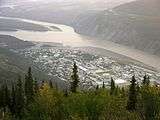Klondike River
The Klondike River (Hän: Tr'ondëk) is a tributary of the Yukon River in Canada that gave its name to the Klondike Gold Rush. The Klondike River has its source in the Ogilvie Mountains and flows into the Yukon River at Dawson City.
| Klondike River | |
|---|---|
Klondike River crossing Dempster Highway (upstream) | |
| Native name | Tr'ondëk |
| Location | |
| Country | Canada |
| Territory | Yukon |
| Physical characteristics | |
| Source | Ogilvie Mountains |
| Mouth | Yukon River |
• location | Dawson City, Yukon, Canada |
• coordinates | 64°03′08″N 139°26′27″W |
| Length | 160 km (99 mi) |
| [1][2] | |
Its name comes from the Hän word Tr'ondëk (/ʈʂʼontək/) meaning hammerstone, a tool which was used to hammer down stakes used to set salmon nets.
Gold was discovered in tributaries of the Klondike River in 1896, which started the Klondike gold rush, and is still being mined today.
In Jack London's story "A Relic of the Pliocene" (Collier's Weekly, 1901), this river was mentioned as "Reindeer River". (See Reindeer Lake.)
Gallery
 Klondike River (left) flowing into the Yukon River (top and right) at Dawson City
Klondike River (left) flowing into the Yukon River (top and right) at Dawson City- Klondike River crossing Dempster Highway (downstream)
- Mouth of the Klondike River to the Yukon River at Dawson City
gollark: Because you can discuss things without liking them?
gollark: There's no technical reason they should only last 8ish years.
gollark: Primarily batteries, and kind of screens if you're prone to dropping them a lot like me. Also charging ports.
gollark: Some parts tend to degrade over time, and I'd definitely want those to be swappable.
gollark: I at least want hardware I can actually replace/upgrade parts in.
See also
References
| Wikimedia Commons has media related to Klondike River. |
- "Klondike River". Encyclopædia Britannica Online. Retrieved 5 March 2010.
- "Klondike River". Natural Resources Canada. Archived from the original on 8 June 2011. Retrieved 5 March 2010.
This article is issued from Wikipedia. The text is licensed under Creative Commons - Attribution - Sharealike. Additional terms may apply for the media files.